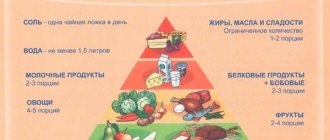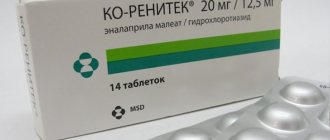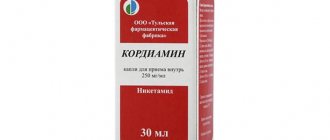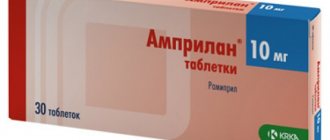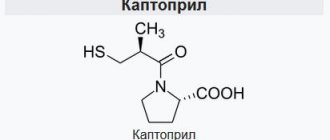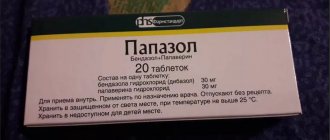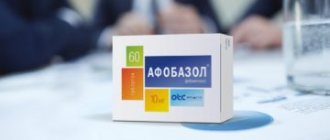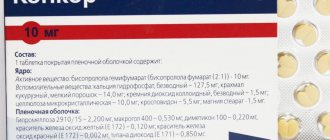Contraindications and side effects
The drug should not be used in patients who have hypotension, that is, decreased systolic and.
Also contraindications are acute heart failure, aortic stenosis, hypersensitivity to the components of the drug, cardiogenic shock, acute myocardial infarction. The medication is not prescribed to patients during pregnancy and lactation. The medicine is not yet used in pediatrics. During therapy you should not drink alcoholic beverages. It is possible to drive vehicles and operate potentially dangerous machinery during treatment. Side effects:
- Frequent urge to urinate. Impairments in kidney function are possible.
- Allergic reactions.
- Functional disorders of the cardiovascular system. When using the medication, tachycardia, hyperemia, hypotension, and flushing of the face may develop. Bradycardia, worsening angina pectoris, ventricular tachycardia, and asystole were extremely rarely observed.
- Thrombocytopenia.
- Malfunctions of the digestive system. Patients may experience headaches, heartburn, nausea, and liver problems. It has been reported that when consuming higher doses, abdominal pain, increased activity of liver enzymes, cholestasis, and gingival hyperplasia are possible.
- Gynecomastia in men.
- Functional disorders in the peripheral and central nervous systems. Phenigidine can cause visual disturbances, tremors of the limbs, muscle cramps, insomnia or drowsiness, and paresthesia.
- Leukopenia.
In case of an overdose of the drug, hypotonic shock, bradycardia, and cardiac conduction disturbances develop.
Contraindications
The above complications confirm the opinion of doctors that any medicine can cause malfunctions in the body.
It is natural that in addition to various complications, there are also rules and prohibitions on taking medications. Phenyhydinum is no exception to this and also has its own list of contraindications:
- tendency to be allergic to Nifedipine and other components in the composition;
- the first time of recovery after a heart attack;
- persistent hypotension;
- narrowing of the aorta;
- decompensated heart failure and severe myocardial pathologies;
- cardiopalmus;
- pregnant and lactating women;
- children under 18 years of age.
It is worth noting that experimental studies by scientists were able to reveal the toxic effect of Nifedipine on fetal development.
Side effects
- digestive system: very often – constipation; often – dry mouth, nausea, dyspeptic disorders, diarrhea, increased gas formation; rarely - vomiting, inflammation of the gum mucosa, regurgitation, gingival hyperplasia, anorexia, liver dysfunction, increased levels of gamma-glutamyl transferase; very rarely - hepatitis, intestinal obstruction, esophagitis;
- cardiovascular system: very often - peripheral edema, rapid heartbeat, symptoms of excessive vasodilation (flushing of the facial skin, flushing of the facial skin, feeling of heat, asymptomatic decrease in blood pressure); often – orthostatic hypotension, tachycardia, decreased blood pressure, fainting; very rarely - myocardial infarction, most likely a consequence of the underlying disease;
- respiratory system: often – dyspnea; rarely – nosebleeds; very rarely - shortness of breath, bronchospasm, laryngeal edema;
- central nervous system: very often – headache, dizziness, lethargy; often - drowsiness or insomnia, systemic dizziness, paresthesia, increased nervous excitability; rarely - sleep disturbance, mood lability, hyperesthesia, tremor;
- sense organs: rarely – pain in the eyes, visual disturbances;
- musculoskeletal system: often – spastic contraction of the lower leg muscles; rarely – pain in muscles and joints;
- genitourinary system: often – polyuria, night urination; rarely – impotence, dysuria; very rarely – temporary deterioration of renal function (when taking the drug in patients with renal failure);
- hematopoietic system: very rarely - thrombocytopenia, anemia, thrombocytopenic purpura, leukopenia;
- endocrine system: very rarely - gynecomastia (mainly in elderly patients and after long-term therapy);
- skin: very often - rash, itching, urticaria, vesiculobullous or pustular rash, feeling of heat, facial redness, exfoliative dermatitis, sweating, Quincke's edema, hypersensitivity reactions;
- general reactions: often - weakness, pain in the chest, abdomen and legs; rarely – chills, fever, chest pain, facial swelling, allergic reactions.
Overdose
In case of an overdose of Phenigidine, in addition to the side effects listed above, the following symptoms may be added (depending on the degree of intoxication): angina pectoris, a significant decrease in blood pressure, ventricular or nodal extrasystole, loss of consciousness, fainting or bradycardia, collapse, inhibition of insulin secretion. In particularly severe cases, hyperkalemia, hypoxia, disturbances of consciousness leading to a state of coma, cardiogenic shock with pulmonary edema and metabolic alkalosis are possible.
There is no specific antidote for Phenigidine, so emergency therapy is carried out aimed at removing nifedipine from the body and restoring normal parameters of the cardiovascular system.
In case of intoxication with the drug, the stomach should be rinsed with activated charcoal, and, if necessary, the small intestine. Laxatives are not always effective, since calcium channel blockers can suppress intestinal motility to the point of complete atony. Hemodialysis is ineffective. Plasmapheresis is possible (since the drug binds in large quantities to plasma proteins and has a relatively small volume of distribution). For symptomatic treatment of bradycardia, beta-sympathomimetics and/or atropine can be used. For life-threatening bradycardia, it is necessary to use artificial heart pacemakers.
To eliminate severe arterial hypotension, dopamine is administered (at a maximum dose of 25 mcg/kg body weight per minute), calcium gluconate (1-2 g intravenously in a stream, then slowly as an infusion), adrenaline, norepinephrine or dobutamine (at a maximum dose of 15 mcg/kg body weight per minute). Doses of these drugs are selected taking into account the patient's response. Serum calcium concentration may be normal or slightly elevated
Additional fluid is administered with caution and hemodynamic monitoring to avoid cardiac overload.
Instructions for use and dosage of Phenigidine for blood pressure
Phenigidine tablets should be taken several times a day. The intake must be combined with a meal. Depending on blood pressure readings, the doctor determines a single dose. However, the amount of active substance consumed per day should not exceed 120 mg. Otherwise, the likelihood of an overdose increases. The average dosage is 20 mg of the drug. The duration of treatment is determined individually. In case of an acute attack of hypertensive crisis, several tablets are used at a time, chewing them and holding them until completely dissolved under the tongue. One of the options to stop the crisis is to use “Phenigidine drops” for blood pressure.
Return to contents
Use during pregnancy and lactation
The medication can provoke the development of fetal pathology.
Bearing a child is a reason to stop treatment with Phenigidine.
You need to monitor therapy especially carefully in the early stages of pregnancy. The substance nifedipine, which is part of the drug, negatively affects the fetus and provokes irreversible changes. Breastfeeding should be stopped during therapy with Phenigidine. This is due to the ability of the ingredients to penetrate into milk and, accordingly, into the child’s body. A return to natural feeding is possible 1-2 days after taking the last dose of the medicine.
special instructions
Phenigidine must be used under the strict supervision of a physician, and in case of myocardial infarction, diabetes mellitus , diseases of the hepatic system, pathology of cerebral circulation, hypovolemia, hemodialysis - only in a clinical setting.
The dose is increased and decreased gradually. Abruptly stopping treatment can be dangerous. For the elderly, a dose reduction is recommended due to reduced metabolism. For speedy absorption, it is recommended to dissolve the tablet under the tongue until completely dissolved. During treatment, alcohol and substances that lower blood pressure are not allowed.
During the treatment period, it is not recommended to drive various types of transport, machinery or carry out work that requires increased attention and concentration.
Side effects
If there are symptoms of individual intolerance, the drug should be stopped immediately
Phenigidine has a rapid action and effectively reduces blood pressure during a hypertensive crisis. However, the medicine may be unsafe as it often causes side effects. The list of adverse reactions is quite wide:
- from the heart and blood vessels: edema, hypotension, bradycardia, arrhythmia, tachycardia, hot flashes, myocardial infarction;
- from the respiratory system: nasal congestion, dry nasal mucosa and throat, nosebleeds;
- from the central nervous system and PNS: migraine, vertigo, weakness, drowsiness, fatigue, paresthesia;
- from the gastrointestinal tract: loss of appetite, stomach pain, constipation or diarrhea, nausea;
- from the liver and gall bladder: jaundice, cholestasis, cholecystitis;
- from the psyche: anxiety, nightmares, insomnia;
- other side effects: erectile dysfunction, decreased libido, muscle cramps, gynecomastia, hyperglycemia.
The drug can cause severe allergic reactions, including angioedema. There are known cases of the development of anaphylactic shock in patients with intolerance to the main active substance.
Reviews about Phenigidine
Analysis of information on medical portals led to the conclusion that this drug is considered outdated, and many restrictions on use force doctors to prescribe safer and more modern analogues. Reviews report that the development of side effects is quite common. In this regard, many forum participants are worried about their health, but at the same time unanimously confirm the effectiveness of this drug, especially during attacks of angina pectoris and a sharp increase in systolic pressure.
Phenigidine differs from other antihypertensive medications in the presence of additional effects, because the active substance not only reduces blood pressure, but also has an antiatherosclerotic effect. The opinions of patients on this matter are divided: some choose an effective drug for hypertensive crises, turning a blind eye to pronounced side effects, while for others it is preferable to take safe, modern drugs that not only smoothly lower blood pressure, but also do not cause negative reactions.
Indications for use
The most widely used antiarrhythmic drugs are verapamil and nifedipine. Doctors use them in the treatment of supraventricular arrhythmias. The medications also prevent the negative inotropic effect on the muscle of the heart chambers and, as a result, further deterioration of the left ventricular ejection fraction.
Nifedipine has an adverse effect on patients with acute myocardial ischemia and left ventricular dysfunction. It increases mortality when treating unstable angina. There was no evidence of a reduction in mortality from nifedipine in patients after myocardial infarction (MI). For this reason, the use of this drug in patients with acute coronary syndromes is inappropriate.
Myocardium
A recent meta-analysis was conducted of 22 studies involving 18,000 patients who had a MI. Nifedipine (9400 patients), verapamil (3500 patients), diltiazem (3100 patients) and lidoflazin (1800 patients) were tested in patients. CCBs did not reduce the mortality rate or the rate of recurrent myocardial infarction. However, it is worth noting that nifedipine was used in a rapid-acting form and the results may not be generalizable to the entire chemical or heterogeneous group of CCBs.
In a meta-analysis of patients treated for hypertension who took nifedipine, 60% had a higher risk of a first MI than patients taking beta-blockers or diuretics. Short-acting nifedipine was used in the studies. Furberg concluded that the short-acting dosage form of nifedipine administered to post-MI patients at intermediate and higher doses increased overall mortality.
Nifedipine has comparable efficacy to beta-blockers, long-acting nitrates and trimetazidine in the treatment of stable forms of angina.
Nifedipine, given between 3 and 15 days after MI in the MDPIT trial (total of 2466 patients), had a beneficial effect on survival and recurrent MI, but only in patients without left ventricular dysfunction or myocardial failure. The drug did not have a positive effect on patients with LV dysfunction. In some cases, it even worsened the prognosis of the disease.
The Norwegian study included patients after their first MI. The researchers assessed the effect of controlled-release nifedipine administered between 36 and 96 hours after thrombolysis. The drug reduced the incidence of cardiac death over 6 months, but the result was not statistically significant.
According to the European and Czech Society of Cardiology, long-acting nifedipine can be used to treat acute coronary syndromes without ST elevation. It is recognized that it can be used in addition to beta-blockers and nitrates. Nifedipine is considered a suitable treatment option for vasospastic angina. In case of MI with ST-segment elevation, its use is strictly prohibited.
The benefit of treatment with nifedipine (monotherapy) for various vascular diseases has not been proven. This drug is effective in combination with other medications. Therefore, CCBs are usually used together with other antihypertensive agents, in particular beta blockers, dehydrating agents (diuretics) or ACE inhibitors.
Diuretic
The main disadvantage of nifedipine is the increased incidence of heart attacks and heart failure compared to other drugs such as beta blockers and ACE inhibitors.
Interaction
Concomitant administration of drugs that interact with the cytochrome P450 3A4 enzyme system affects plasma concentrations of the drug. An increase in the plasma concentration of nifedipine (due to a decrease in the activity of cytochrome P-450) can result from interaction with certain antibiotics (erythromycin), cimetidine (increase in plasma concentration by up to 50%), imidazole, antifungals (itraconazole, ketoconazole) and flavonoids contained in in grapefruit juice.
Enzyme inducers (for example, barbiturates, phenytoin, carbamazepine) reduce the plasma concentration of nifedipine.
A slight increase in metoprolol concentrations has been described when administered concomitantly with nifedipine. In general practice, combining the drug with beta blockers is a very common and useful combination.
Important! Short-acting nifedipine may do more harm to patients than good. Before using the medicine, you need to consult your doctor and evaluate all possible risks.
Description of the drug
Phenigidine has established itself as a fast-acting drug that normalizes blood pressure. It is an antihypertensive and antianginal agent. Its main task is to block the flow of calcium ions into cardiomycytes and arterial cells.
Release form and price
The drug is available in the form of yellow tablets in contour packaging of 50 pcs. (10 tablets in one blister). They are small in size and flattened in shape, making them easy to take. You can also see Phenigidine on sale in the form of drops (Phenigidin-Health), capsules, and solution for injection.
The price of the drug depends on the form of release. The average cost of tablets today is 36 rubles.
Composition and mechanism of action
The main active ingredient is nifedipine, 10 mg in each tablet. The product also contains several additional substances, the effects of which are presented in the table.
| Components | Properties |
| Lactose monohydrate | Gives additional flowability. Acts as a sweetener. |
| Corn/potato starch | Promotes the connection of all components, allows you to achieve the required volume and mass. |
| Rafinated sugar | Performs a connecting function. |
| Polysorbate-80 | It is a food additive and helps to bind the ingredients of the medicine. |
| Calcium stearate | Acts as a thickener and promotes the formation of a certain tablet shape. |
Before you start taking the drug, you should figure out at what pressure you can drink it. The active substance of the drug acts as an antagonist of calcium ions and helps block calcium channels. Taking tablets is prescribed for high blood pressure.
As a result, peripheral and cardiac vessels dilate, and blood pressure gradually decreases. This significantly reduces the load directly on the heart. Also, taking Phenigidine leads to an improvement in coronary blood flow and makes heart contractions more energy-intensive. This fact is important for patients with ischemic heart pathologies.
Phenigidine - at what pressure to take
Update date: 09/07/2019
Professor of Medicine G. F. Lang was the first to introduce hypertension into a number of individual pathologies in 1922.
The scientist has been researching this complex disease for many years and discovered hypertension as a multifactorial disease with many underlying causes.
The academician’s conclusion turned out to be correct and became the beginning of not only a multifaceted approach to the study of the disease, but also to its treatment and the development of a large number of dosage forms with various spectrums of action.
One of the scientific solutions “with history” is the active substance nifedipine. On the pharmaceutical market it can be found in the medicine Phenyhydinum (Phenyhydinum in Latin).
Letters from our readers
Effect on blood pressure
Undoubtedly, a big advantage that allows a drug based on nifedipine to successfully compete with medications - hypotensive drugs of the new generation, is considered to be a fairly simple algorithm of action:
- the active substance, being an antagonist of Ca ions, prevents their entry into cardiomyocytes and smooth muscle cells of the vascular network;
- vascular tone weakens;
- coronary blood circulation improves;
- blood pressure decreases;
- the overall load on the heart muscle and its need for oxygen decreases.
In general, Phenyhydinum not only allows you to protect an important human trunk network - the circulatory system, but also the main component of the body and its “motor” - the heart.
Indications for use
Medical specialists have been using the drug's multifunctionality for many years to treat a range of health problems.
Heart and blood vessels:
Bronchopulmonary system:
- increased pressure in the pulmonary artery;
- complicated bronchial patency.
The most detailed information about the medicine and its properties is presented in the instructions for Phenigidine.
Release form
On the pharmacy display, Phenyhydinum is usually presented in tablet form for oral use.
Cardboard packaging No. 50 most often contains 5 plastic blisters of 10 units each.
In addition, the product is sold in plastic containers No. 50.
Compound
Each tablet contains 10 mg of the main active agent Nifedipine.
Additions to the main active substance are: refined and milk sugar, calcium stearate, starch, polysorbate 80.
Price
It is worth noting that due to its low cost, the blood pressure medication Phenigidine is available to all social segments of the population.
The pricing policy for cardio medications for residents of central Russia in online pharmacies is more than loyal: for tablets 0.01 g No. 50 – 25.00-29.00 rubles.
The cost is indicated for a domestically produced medicine.
Instructions for use
When prescribing a hypotensive drug, the attending physician, as a rule, is guided not only by the instructions for Phenigidine, but also by the results of the examination of the patient, information about age and other individual characteristics.
The initial dosage per dose is 10 mg, maximum 4 times a day. If therapy is ineffective, the daily dose can be increased to 2 tablets 3 times. It is allowed to take no more than 120 mg in 24 hours.
If you suspect a hypertensive crisis, you must take a lying position, put a tablet (1-2) on the root of your tongue and wait for complete resorption. For heart pain, the initial dose is 0.01 g three times within 24 hours. Any necessary adjustments should be made under the supervision of a qualified technician.
To avoid undesirable consequences for the body, it is better to take Phenyhydinum during or after meals. The therapeutic course generally does not exceed one or two months.
In childhood and adolescence
The annotation for the drug prohibits its use for the treatment of patients under 18 years of age.
In old age
For hypertensive patients aged 60 years and older, the requirements for the dosage of cardiac medications are more serious than for young people.
General practitioners and cardiologists take into account factors such as:
- general health;
- individual characteristics;
- contacts with other medications;
- quality of metabolism;
- liver health.
Typically, for the age category, initial prescriptions of 5 mg are provided.
Side effects
The instructions for Phenigidine include precautionary measures, the observance of which will help to avoid various complications and carry out the therapeutic course as prescribed.
- Cardiology and breathing. External signs include redness of the skin along with a feeling of heat. Internal symptoms include a drop in blood pressure, manifestations of arrhythmia, pain in the heart, and the occurrence of edema in the periphery. Shortness of breath.
- Neurology and sensory organs. In some cases, patients experience headaches and dizziness. Rarely, visual disturbances, sleep and attention disturbances, tremors, and impaired sensitivity of the limbs are observed (after long-term use).
- Hematopoiesis. Decreased levels of red blood cells, white blood cells and platelets (in some cases). Clinic of idiopathic thrombocytopenic purpura.
- Gastrointestinal and urinary apparatus. Patients complain of stool instability, bloating, and nausea. Liver problems, gum hyperplasia (with long-term use). Increased urination, especially at night.
- Skin and endocrinology. Possible local allergic reactions in the form of irritation, rash. Swelling of the mammary glands (isolated cases in men).
It has been noticed that some of the above side effects manifest themselves only at the beginning of treatment with Phenigidine, and then go away on their own.
If you experience any deterioration in your health, you should consult your doctor.
Contraindications
The above complications confirm the opinion of doctors that any medicine can cause malfunctions in the body.
It is natural that in addition to various complications, there are also rules and prohibitions on taking medications. Phenyhydinum is no exception to this and also has its own list of contraindications:
- tendency to be allergic to Nifedipine and other components in the composition;
- the first time of recovery after a heart attack;
- persistent hypotension;
- narrowing of the aorta;
- decompensated heart failure and severe myocardial pathologies;
- cardiopalmus;
- pregnant and lactating women;
- children under 18 years of age.
It is worth noting that experimental studies by scientists were able to reveal the toxic effect of Nifedipine on fetal development.
Overdose
Failure to comply with the prescribed dose can lead to a lot of complications, including extremely dangerous ones:
- a sharp drop in blood pressure leading to loss of consciousness;
- rare pulse;
- disorders of myocardial contractility;
- cardiogenic shock and collapse (especially severe forms of vascular insufficiency).
Due to the seriousness of the situation, in case of poisoning with Phenigidine, in the first hour you should immediately rinse the stomach, followed by the use of absorbent substances.
Interaction with other drugs
When using Phenyhydinum for blood pressure, it is necessary to take into account the features and risks of its contact with other pharmaceuticals:
- with hypotensive drugs, the antihypertensive effect increases;
- with anti-asthma medications, memory impairment occurs in elderly hypertensive patients;
- with beta-blocker substances, blood pressure significantly decreases and heart failure develops;
- with drugs based on Ca, the anti-tuberculosis antibiotic Rifamycin, a group of barbiturates - the healing abilities of Nifedipine deteriorate;
- with cardiac glycosides, their natural removal from the body slows down;
- myalgia occurs with Mg salts;
- with alcohol the hypotensive effect is enhanced.
It is important to remember that only a medical specialist has the skills of pharmacology. Without his participation, even after studying the instructions for use of Phenigidine, you cannot use other medications in parallel.
Analogs
Drugs with Nifedipine on pharmacy shelves are always available from different manufacturing countries. The most famous generics:
- Corinfar retard (Germany, AWD pharma);
- Cordafen (Poland, Pharmaceutical Works POLPHARMA);
- Kordipin retard (Slovenia, KRKA).
Storage conditions
The blood pressure medication Phenigidine is registered in List B of drugs and is not dispensed without a doctor’s prescription.
According to the attached annotation, it should be stored in a place protected from children without access to light and humidity. Shelf life is 3 years at temperatures from 8 to 15 degrees Celsius.
Recommendations
Phenigidine is an available antihypertensive drug that blocks the entry of calcium into blood vessels, thereby reducing vascular resistance. Taking the medication improves coronary blood flow and has a positive effect on myocardial function, reducing the need for oxygen in the heart muscle.
The drug also has the property of preventing blood clots.
The attending physician prescribes a schedule for taking the drug, taking into account all the characteristics and concomitant diseases of the patient. It is very important to follow all the doctor’s instructions, since complications of the disease can not only reduce the patient’s quality of life, but also lead to death.
Why is hypertension not treated in Russia?
Hypertension, unfortunately, always leads to heart attack or stroke and death. Only constant use of antihypertensive drugs could allow a person to live.
Now there is a chance to restore blood vessels...
Read more Was this article helpful?
Rate the material on a five-point scale!
( 3 4.67
Source: https://otgipertonii.ru/preparaty/fenigidin-pri-kakom-davlenii-prinimat/
Pharmacological properties
Pharmacodynamics
Phenigidine is a dihydropyridine-type vasodilator that has antihypertensive and antianginal effects. It inhibits the flow of calcium ions into arterial smooth muscle cells and myocardial cells, and also reduces the intracellular release of calcium, which leads to relaxation of the muscles of the coronary and peripheral arteries.
When the arteries dilate, peripheral vascular resistance decreases, as a result, the myocardial oxygen demand decreases and afterload is weakened. Phenigidine dilates atherosclerotic and intact coronary arteries, thereby protecting the heart from coronary spasm and improving blood supply to ischemic myocardium. With normal blood pressure levels, the drug has no or almost no effect on its value.
Due to the expansion and suppression of spasm of the coronary arteries, myocardial oxygenation improves.
Pharmacokinetics
More than 90% of Phenigidine is completely absorbed in the gastrointestinal tract. The bioavailability of the drug is 40–70%. During the first passage through the liver, up to 40–60% of Phenigidine is intensively metabolized.
Maximum plasma concentrations are achieved 30–60 minutes after oral administration of one 10 mg tablet. The drug is 91–94% bound to plasma albumin. The half-life is 2–4 hours.
Nifedipine is excreted in breast milk and penetrates the placental barrier. Less than 5% of the administered dose of the drug penetrates the blood-brain barrier.
As a result of the metabolism of Phenigidine, 3 pharmacologically inactive metabolites are formed. About 60–80% of the dose taken is excreted in the urine in the form of inactive metabolites, the rest is excreted in feces and through the biliary tract.
Indications and contraindications
What should I take Phenigidine for? The main area of application is the prevention and elimination of symptoms of angina pectoris. The presence of the following pathologies is also considered indications for use:
- Raynaud's disease/syndrome;
- arterial hypertension;
- spasms of the coronary arteries.
Raynaud's syndrome
The drug has a number of contraindications:
- arterial hypotension (low blood pressure);
- individual hypersensitivity to components;
- pregnancy/lactation period.
The drug can be taken with extreme caution in case of severe cerebrovascular accidents, severe tachycardia, gastrointestinal obstruction, renal or liver failure.
In adulthood, it is necessary to take pills under the supervision of a doctor. Based on the patient’s condition, he prescribes the dose and number of doses per day. This is due to the slow elimination of the active substance from the body.
Interaction of the drug with other medications
Is it possible to take Phenigidine Health together with other drugs? The instructions included in the package warn that a person’s well-being may noticeably deteriorate if the medicine we are considering is used incorrectly. In this regard, before taking it, we recommend that you first consult with your doctor.
When used simultaneously with diuretics, antihypertensive agents and phenothiazine derivatives, the antihypertensive effect of nifedipine may be enhanced.
When used simultaneously with anticholinergic drugs, attention and memory impairment may occur in patients of pre-retirement and retirement age.
If the drug is taken simultaneously with beta-blockers, a person may develop severe and, in some cases, heart failure.
When used simultaneously with nitrates, the antianginal effect of nifedipine increases.
A one-time intake with calcium reduces the effectiveness of the active element. This is due to an antagonistic interaction, which is caused by an increase in the concentration of calcium ions in the so-called extracellular fluid.
There are known cases of the development of muscle weakness and general fatigue while taking the drug with magnesium salts.
If you use Phenigidine together with digoxin, this can slow down the removal of the latter from the body, which will subsequently cause an increase in its concentration in the blood.
Co-administration of the drug with diltiazem enhances the antihypertensive effect.
When used simultaneously with theophylline, there is a possibility of changes in the concentration of the latter in the blood plasma.
The substance rifampicin can induce the activity of liver enzymes and also accelerate the metabolism of nifedipine, which ultimately leads to a significant decrease in its effectiveness.
If you use the drug simultaneously with phenytoin, phenobarbital and carbamazepine, then there is a possibility of a decrease in the concentration of the active substance in the blood plasma.
There are many reports of an increase in the concentration of nifedipine in the blood plasma, as well as an increase in its AUC when used simultaneously with itraconazole and fluconazole.
If you take the drug together with fluoxetine, there is a possibility of increased side effects of nifedipine on the human body.
In rare cases, simultaneous use of a drug with quinidine can reduce the concentration of the latter in the blood, and when the drug is discontinued, it can significantly increase it, which, naturally, will contribute to the prolongation of the QT interval on the ECG.
Active ingredients such as ranitidine and cimetidine sometimes increase the concentration of nifedipine in the blood, enhancing its antihypertensive effect.
Medicines containing alcohol may increase the effects of nifedipine, which can cause dizziness and other unwanted reactions.
Drug interactions
The drug "Phenigidine" can interact with other drugs. Moreover, the combinations are not always favorable. When prescribing the drug, the doctor should take into account interactions with such drugs as:
- Diuretics, beta-blockers and other antihypertensive pills. Together with them, blood pressure decreases excessively.
- Anticholinergic medications. When taken simultaneously with them, the patient may experience memory impairment and impaired concentration. This is especially true for older people.
- Calcium preparations. In combination with them, the therapeutic effect of Phenigidine is reduced.
- Magnesium salts. Interacting with them, the medication causes weakness in muscle tissue.
- Diltiazem. Taking it together leads to a strong decrease in blood pressure.
- Rifampicin. When used simultaneously with it, the effect of Phenigidine worsens.
- Fluoxetine. In combination with it, it is possible to increase the risk of developing adverse reactions of an antihypertensive drug.
You should also not combine the use of Phenigidine with alcoholic beverages. Otherwise, the patient will experience side effects.
Relative contraindications
And these are pathologies that are marked “use with caution.” What does the following mean: the doctor will evaluate the risk/benefit ratio, and on this basis decide whether to prescribe Phenigidine to the patient, or whether the threat posed by it is clearly higher than the potential benefit
These relative contraindications are:
- Chronic heart failure – this diagnosis refers to a condition in which the volume of blood pumped out by the heart decreases. This means that the pumping function of the main organ of the cardiovascular system suffers, and organs and tissues experience oxygen deficiency. The doctor must assess the severity of the disease, and based on the assessment, prescribe or not prescribe a drug based on nifedipine.
- Disorders of the kidneys and liver. The doctor, based on tests and other diagnostic methods, will draw a conclusion about the severity of nephro- and hepatopathologies, and then may prescribe Phenigidine or refuse such a prescription.
- Diabetes. It refers to a whole group of endocrine diseases, which is based on disturbances in the absorption of glucose and, accordingly, a deficiency of its own effective insulin. The disease is chronic and its course can be progressive.
- Circulatory disorders in the brain of ischemic and hemorrhagic types. This is either a stroke or states of short-term ischemia of acute ischemia of the brain, which are accompanied by transient attacks.
- Severe hypertension that is not amenable to drug therapy. Otherwise, it is also called malignant hypertension. This is a severe pathology, which is characterized by a rapidly progressive course of hypertension.
Description
This pharmaceutical is produced in two dosage forms - tablets and drops. But the latter, it is worth noting, are rarely found on sale, which is why doctors often prescribe the medicine to patients in tablet form.
One serving contains 10 mg of the main component, nifedipine. The auxiliary composition is represented by lactose monohydrate, potato starch, gelatin, cellulose. Additional ingredients are used mainly for shaping.
Since the medicine is produced by different pharmaceutical companies, the appearance of the products, as well as the volume of packaging, may vary. But usually there are 50 tablets on sale, with ten in one blister. The medication is sold by prescription.
Composition and release form
"Phenigidine" is a tablet anti-hypertensive drug. The action is based on the property of blocking calcium ions. The drug has a round, flattened shape. There are stripes on the sides of the dragees. The color of the tablets is yellow or with a slight green tint. The substance that determines the properties of the drug is nifedipine. The tablet contains 10 mg. In addition to it, Phenigidine also contains other components presented in the table:
Enter your pressure
Move the sliders
120 by 80
| Tablet Component | Functions and properties |
| Potato or corn starch | Has pharmaceutically neutral properties. By adding the component to the tablets, the required weight and volume are ensured. It also binds the ingredients together. |
| Lactose monohydrate | Acts as a sugar substitute. Provides additional filling and flowability. |
| Rafinated sugar | A substance that performs binding functions. |
| Calcium stearate | A fat-like substance used to help the tablet glide throughout the body. |
| Polysorbate-80 | Food supplement. Acts as a fixing agent between ingredients. |
Analogs
Among the analogues, we can distinguish the ones that are closest in all characteristics. These are Adalat, Vero-Nefidipin, Zanifin, Kordafen, Nicardia and a number of other consonant names
It is important to note that despite all the similarities of the analogues, their effects on the patient’s body may differ. To avoid possible negative reactions of the body, you need to know the opinion of the attending physician about the proposed drug
Adalat is available in 50 ml bottles. It is a 0.01% solution of the drug. Cordafen is produced in Poland. The dosage form of the drug is 10 mg tablets in package No. 50. Hungary produces Cordaflex in several modifications and in various packages.
Adalat Nefidipin Cordafen Nicardia
The cost of the drug in Ukrainian pharmacies ranges from 6 hryvnia. These fluctuations largely depend on the dosage form of the drug, because the content of Phenigidine differs in different forms.
Directions for use and dosage
Phenigidine is taken orally before meals. The tablet is swallowed whole, without chewing and washed down with a small amount of water.
The dosage regimen is determined by the attending physician individually. When selecting a dose, the severity of the disease and the patient’s response to the treatment are taken into account.
The initial dose of Phenigidine is 10 mg (1 tablet) 2-3 times a day. If necessary, increase the dose to 20 mg (2 tablets) 1–2 times a day. The maximum dose of the drug is 40 mg per day.
To accelerate the therapeutic effect of Phenigidine at the beginning of a hypertensive crisis or an attack of angina, chew the tablet, hold it in the mouth for a while, then swallow it with a small amount of liquid.
Since the main metabolism of the drug occurs in the liver, its dose should be selected taking into account the state of the patient's liver function.
In patients with impaired renal function, no dose adjustment is required.
The pharmacokinetic parameters of Phenigidine in elderly patients change, so lower doses of the drug may be required to achieve sufficient therapeutic effect.
Doses and treatment regimen
The doctor will always set the dose of the drug on an individual basis: it depends on the indications, the severity of the disease, and the presence of concomitant diseases.
Take the medicine after meals or during meals. The portion should be swallowed immediately, without chewing/crushing. Be sure to drink it with water. The starting dosage is 30 mg, divided into three doses. It turns out that you need to drink 10 mg 3/24. That is, three tablets per day. The doctor can reduce the dosage, increase it, but only the doctor – the patient himself – does not adjust the dosage regimen. In this case, the peak daily dosage is 40 mg.
The dose is always reduced for persons with hepatopathologies, renal dysfunction, as well as for those who suffer from cerebrovascular accidents.
Who is it shown to?
What are Phenigidine tablets for? The main indication for use is arterial hypertension, relief of hypertensive crises, as well as relief of angina attacks. It also serves as a means to prevent angina attacks. This medication is also prescribed for the treatment of Raynaud's disease.
And now some detailed information about these appointments:
- Angina pectoris. This pathology develops due to the fact that the heart muscle does not receive enough oxygen. This is perhaps the most common form of coronary artery disease, which should definitely be interpreted as a signal of problems with cardiac blood flow. Men, based on statistics, suffer from angina pectoris three or even four times more often than women. Usually people over 40 suffer from this disease. Why does the disease occur? The cause of its appearance may also be atherosclerotic plaques, which can be compared to scale inside a kettle. If the flow of blood in the coronary arteries is disrupted, so-called traffic jams occur, and angina pectoris may begin.
- Arterial hypertension. It is a disease without a clearly defined beginning and without a clearly defined cause. But due to some negative factor, the blood begins to press with excessive force on the walls of blood vessels. This increases the pressure. You can live with the disease for several years, not only without noticing it, but also without attaching importance to its symptoms. This is dangerous, because it will definitely progress. And it can affect not only the heart and blood vessels, but also the brain, kidneys, and eyes.
- Hypertensive crisis. And this is one of the consequences of arterial hypertension, a vascular accident. This is the name for a severe emergency condition that is caused by an excessive surge in pressure. Against this background, neurovegetative disorders and disruptions of cerebral hemodynamics may appear, and acute heart failure may develop.
- Raynaud's disease. Under this name lies a disease that is more correctly called a pathological attack-like condition of small blood vessels, manifested by vascular spasm, impaired blood supply to the extremities, chin, ears, nose. The disease can occur due to prolonged stress, as well as under low temperature exposure.
All these pathologies may be a reason to prescribe Phenigidine. But only a doctor can decide this; any self-medication is excluded.
